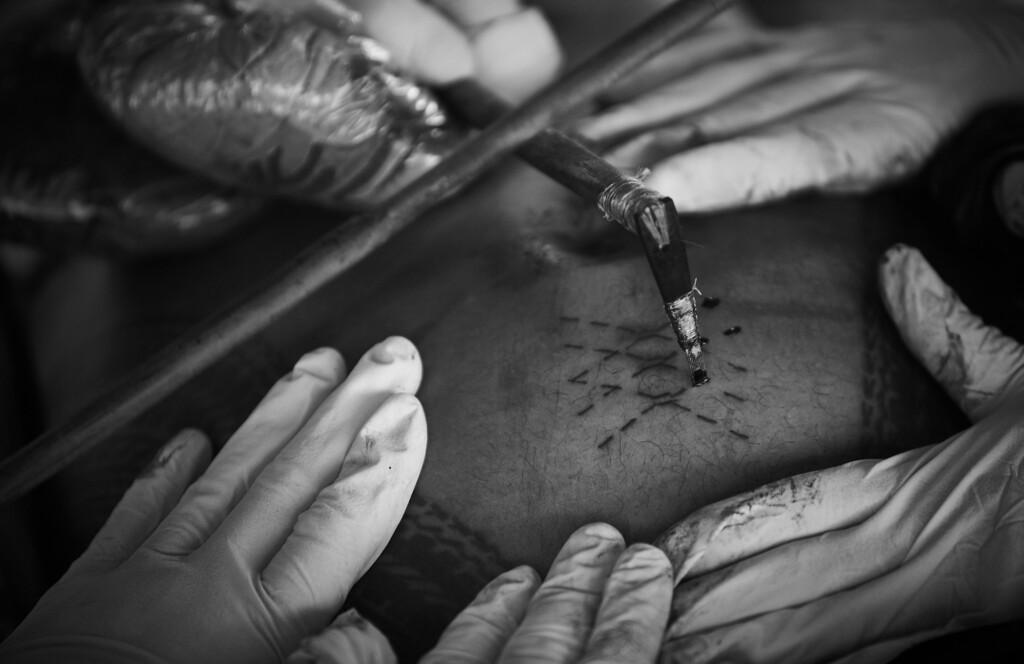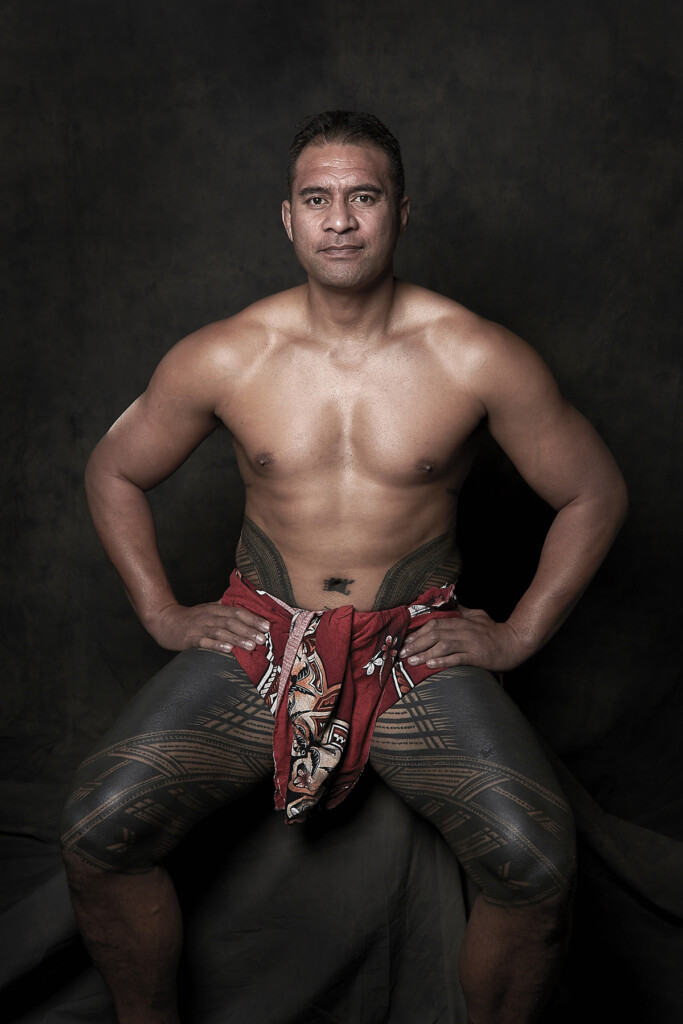To illustrate the everlasting cultural resilience of tatau, among the greatest art forms to emerge in Oceania, the story of Chris Lemuelu is potent in its lucidity. He is a Samoan who lives in Australia and is, as writer Fareed Kaviani has explained, “a soga’imiti, a man who has completed the full pe’a.”
As Tatau: Marks of Polynesia, an ongoing exhibition of more than 150 photographs and narratives representing Samoan tattoo masters at the Utah Museum of Fine Arts (UMFA), portrays, pe’a signifies the coming of age of an individual, a ritual “rich with coded communication and symbolism … [that] can be read like guidebooks to Samoan traditions and culture.”
“It is sacrilegious, almost criminal, to have the pe’a done by someone who hasn’t inherited the title of tufuga,” Kaviani wrote. “There is no turning back once you decide to engage. It doesn’t matter who your family is, it’s really dishonourable and extremely insulting if you don’t complete it. You will be shunned and labelled a pe’a mutu, which is a mark of shame.”
Lemuelu went through the tatau with the universally acknowledged master tattoo artists of Samoa and Oceania (tufuga tā tatau), the father-and-son duo of Petelo and Peter Sulu’ape. “Samoa is still very much a hierarchical society, and the tattoo is used to reinforce an existing order. By receiving the pe’a, Chris became established as a man of status within his community: it marked out his standing in his family, and, as often happens, the pe’a also represents his patrilineal claim to land,” Kaviani explained.
As quoted in Kaviani’s writings, Lemuelu said, “People know that I’ve been through the ritual of pain and tradition. In a sense, you’re seen as having died—gone through the worst pain. I’m treated well; people make sure I’m there at the table eating food first. Now I have the right to make important decisions for my family and my village. I make decisions my older cousins should be making, but people don’t listen to them because they’re not soga’imiti: they listen to me. Like Chuck Norris, I only have to say one word.”
The UMFA exhibition, which continues through the end of the year, puts the definitive exclamation point on the meticulous presentation of the two major forms of tatau — the male tatau (known as pe‘a or malōfie) and the female tatau (known as malu) — as a high art form equal in cultural significance to others that have immortalized sacred rituals and sociocultural histories of peoples. Samoan tatau traditions are at least 3,000 years old and have been sustained through every historical shift, including globalization in the contemporary era. And, as suggested by Sean Mallon and Sébastien Galliot in their widely praised 2018 book TATAU: A History of Sāmoan Tattooing, tatau’s cultural value continues to intensify, having experienced its greatest recognition and visibility since Samoa gained its independence in 1962. In fact, the exhibition also highlights a new generation of tattoo artists’ work within the practice and who are influenced by tatau in a tattoo style known as Contemporary Polynesian.
The exhibition’s provenance is unimpeachable in terms of its cultural authority. The Sulu’ape family granted total access to the principals of this exhibition, allowing them to witness, study, and photograph everything from sacred rituals to family life. The traveling version of the exhibition which is on display at UMFA was organized by the Japanese American National Museum and was curated by Takahiro Kitamura. Photographer John Agcaoili worked closely with a cultural advisory board made up of Sulu‘ape Steve Looney, Danielle Steffany Looney and Sulu‘ape Si‘i Liufau. In addition to providing the necessary cultural information, they fact-checked and sought advice from the grand master Su‘a Sulu‘ape Alaiva‘a Petelo, and his son Su‘a Sulu‘ape Peter.
The UMFA administration also established an advisory board with representatives of Utah’s Polynesian community. “The tatau is a sacred practice and tradition that connects us to our ancestors,” Verona Mauga, co-chair of the UMFA’s advisory committee, said in a prepared statement. “Despite outside pressures dating back to the 18th & 19th century the tatau has survived colonization, missionary influence and western religious views and ideology. This exhibit is the story of an inspired Sulu’ape family who, against all odds and outside influences, fought to preserve their culture, their art, their tools, and their history.” There are approximately 50,000 Pacific Islanders in Utah, which makes the state the fifth largest in terms of population for this ethnic grouping, according to figures from the Kem C. Gardner Policy Institute at The University of Utah. After Hawaii and Alaska, Utah ranks in the top for its share of Pacific Islanders in the state’s population. Samoans represent Utah’s second largest Pacific Islander community.
In their book, Mallon and Galliot finely chronicle the tensions between protecting and shielding the real ethnographic and anthropological significances of tatau elements and the growing prominence of elements such as taulima, the tattooed armband, which has become omnipresent in studios around the world as a quasi-homogeneous Polynesian or neotribal form.
These distinctions also are meticulously elucidated in the UMFA exhibition. “Tatau also reminds us that we are not fully colonized. The Westerners came with their teachings and colonized us with their ways of life, but tatau ties our people back to our responsibilities, history, heritage, and culture,” Su’a Sulu’ape Aisea Toetu’u explained in the documentation of the exhibition. “As tufugas, we can use the two worlds as compass points, in order to navigate in our lives and to make better decisions that cater to the needs of our people through these changing times.”
The most fascinating photographs document the use of the ‘au, the handmade tools, which comprise sharpened bones that have been made into brush-shaped needles and lashed to wooden handles. As noted in the exhibition’s documentation, “As the tufuga had no access to steel needles, boar tusks were sharpened until they could puncture the skin. In recent years, stainless steel needles have replaced bone, but the process remains the same.” Hence, one can imagine the ritual of pain and tradition that Kaviani referenced in describing Lemuelu’s experience. A comb is dipped in black pigment and then a sausau (mallet) is used to tap the ‘au for incorporating the pigment into the skin. The tufuga (master) has two assistants to stretch the individual’s skin so that the needles will pierce the surface.
Visitors can see the exhibition through Dec. 30. This Saturday (Nov. 18), the museum’s monthly Third Saturday for Families event will highlight the exhibition, between noon and 4 p.m. This will include a community voices tour of the exhibition with three members: Jacob Fitisemanu, Jr., cofounder of the Utah Pacific Islander Health Coalition, as well as Samoan Integrated Learning Initiative and West Valley City Council member; Kilisitina Ika, University of Utah second-year biology major from California’s Bay Area and Lita Sagato, OCA Asian Pacific Islander Advocates Utah Chapter president and co-owner of Sagato Bakery & Cafe. There also will be printmaking activities and performances by The University of Utah Samoan Club and students from Mana Academy.
The exhibition is presented by Al and Sue Landon and funded in part by The Joseph and Evelyn Rosenblatt Enrichment Fund.
For more information, see the UMFA website.





